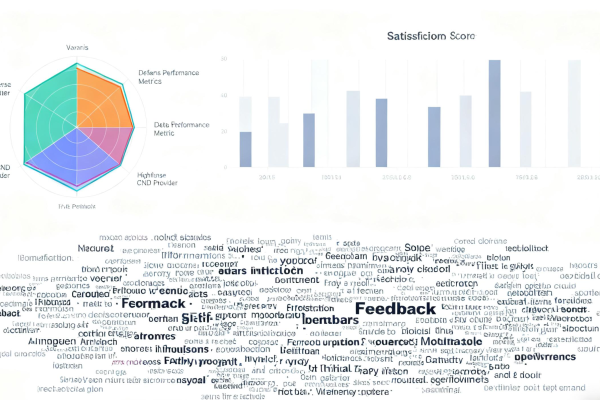Why Do CDN Prices Double? A Guide to the Technical Gaps Behind the Cost Difference
Why do seemingly similar CDNs have twice the price difference? This article breaks down core disparities like bandwidth, nodes, DDoS scrubbing, cache hit ratio, and operations in plain language, helping you choose a CDN that’s "both reliable and cost-effective."

When comparing CDN quotes, a common scenario emerges: two products with similar descriptions—Provider A offers $0.05 per GB, while Provider B charges $0.10 per GB, a full 100% price difference;
Or one costs $70 per month (500 RMB) and the other $170 per month (1200 RMB).
Why is this the case?
Below, we’ll break down the "price difference" into observable, quantifiable dimensions—helping you determine: "Is the cheaper option saving money, or cutting corners? Is the more expensive one a premium or a must-have?"
A doubling of CDN prices typically stems from: bandwidth and scrubbing capabilities, node distribution and backbone connectivity, caching and hit ratio optimization, protocols and dynamic acceleration, SLA/operations and after-sales support, compliance/privacy and value-added features.
Don’t just fixate on the per-GB price—an all-around set of capabilities is what defines true value.
1. Bandwidth & Scrubbing Capabilities: The Biggest Cost Driver
This is the top factor influencing pricing.
- Peak Bandwidth & Redundant Bandwidth
- Low-cost providers often bill based on "average bandwidth" or non-committed bandwidth; high-cost providers advertise "guaranteed baseline bandwidth" and scrubbing pools with peak protection.
- In other words, premium providers reserve "extra capacity" for you, making it less likely to crash during sudden traffic surges.
- Scrubbing Capabilities
- DDoS scrubbing is a major cost for high-defense/enterprise-grade CDNs. Scrubbing centers require large bandwidth, significant computing power, and specialized hardware/software—all of which come at a high cost.
- If a provider claims to defend against "10Tbps+" attacks, their pricing will naturally be higher.
- Real-World Example
- For a mid-sized website under attack, without a scrubbing center, a single day of abnormal traffic could skyrocket your server bandwidth bill; a high-defense CDN blocks attacks at the edge, so you only pay for legitimate traffic—resulting in lower overall costs.
2. Node Distribution & Backbone Connectivity: Closeness to Users Justifies a Higher Price
The claim "more nodes = better CDN" isn’t just marketing—it’s a practical factor affecting both user experience and pricing.
- Node Quantity & Geographic Coverage
- More nodes located closer to your target users mean faster page loads. Differences in node distribution across Asia-Pacific, Europe, and North America directly impact provider pricing.
- For cross-border e-commerce or international businesses, optimizing links in Asia and Southeast Asia requires additional investment (e.g., leasing local data centers, peering agreements)—costs that are passed on to the price.
- Connectivity Quality with ISPs/Backbone Networks (Peering)
- Some CDNs connect directly to ISPs (e.g., via direct links or dedicated lines in local regions), avoiding congested routes; this "premium connectivity" requires negotiations and bandwidth investments, leading to higher costs.
- Cheap CDNs often rely on "generic ISPs" or third-party relays, resulting in poor performance during network congestion.
3. Caching Strategies & Hit Ratio: Same Traffic, Different Bills
CDN costs ultimately depend heavily on Cache Hit Ratio.
- Higher Hit Ratio = Fewer Origin Pulls = Lower Costs
- Top-tier CDNs offer intelligent caching strategies, edge cache persistence, compression, image optimization, and custom cache rules—all designed to boost hit ratios.
- Basic CDNs only cache static files, leading to frequent origin pulls for dynamic requests. This results in higher origin bandwidth usage and server load—so while "traffic volume" seems low, the actual cost is higher due to origin-related resource consumption.
- Edge Computing & Edge Caching
- CDNs supporting Edge Functions/Workers can execute dynamic logic at the edge, significantly reducing origin pulls and latency. However, this capability is typically only available in mid-to-high-tier products at a higher price.
4. Protocols & Tech Stacks: HTTP/2, QUIC, and TLS Acceleration Come at a Cost
Many details impact user experience and provider costs:
- Supported Protocols
- HTTP/2 and HTTP/3 (QUIC) offer significant advantages in concurrency and latency. Deploying these protocols requires advanced edge devices and certificate management systems.
- If your competitors all support HTTP/3 but your cheap CDN doesn’t, your ad landing pages and user interaction experience will suffer noticeably.
- TLS/SSL Acceleration & Certificate Management
- Free certificates are standard, but enterprise-grade features like certificate management, private key protection, automatic renewal, and support for multi-domain/wildcard certificates add administrative costs.
5. Security Capabilities: WAF, Bot Management, and Custom Rules
Security isn’t just "flipping a switch."
- WAF (Web Application Firewall)
- Basic WAF only includes a few default rules, while advanced WAF supports custom rules, learning modes, virtual patches, and vulnerability rulebase updates. The latter requires a dedicated security team to maintain—naturally increasing the price.
- Bot Management & Behavioral Analysis
- Detecting ad fraud, web scrapers, and fake engagement bots relies on behavioral analysis, fingerprinting, IP trust databases, and more. These capabilities require data accumulation and model training—something cheap services can’t deliver.
- Security Incident Response & Forensics
- Premium providers typically offer attack source tracing, traffic replay, long-term log retention, and forensics services—enterprise-grade requirements that add to the cost.
6. Operations & SLA: Human Support Is Worth Paying For
"Expensive" often means paying for human expertise and service capabilities.
- SLA (Service Level Agreement) & Compensation
- Enterprise-grade CDNs provide clear SLAs (e.g., 99.99% uptime), TTR (Time To Resolve) commitments, and compensation mechanisms. Cheap providers usually offer no commitments or minimal compensation.
- Dedicated Account Managers & Technical Support
- Some CDNs offer 24/7 DDoS emergency response, phone support, and expedited rule changes. During critical incidents, this human support minimizes losses.
- Onboarding Optimization & Migration Support
- A CDN’s true value often lies in post-launch optimization (caching strategy tweaks, routing optimization, WAF rule adjustments). If a provider offers these services, the user experience improves significantly—but this is a tangible cost.
7. Billing Models & Hidden Costs: Look Beyond the "Per-GB Price"
Two seemingly identical quotes can have completely different billing structures:
- Pay-as-you-go (Traffic) vs. Peak Bandwidth Billing
- Traffic-based billing seems straightforward, but bills can spike during short-term surges (e.g., ad campaigns, flash sales); peak bandwidth plans are better for scenarios requiring stable bandwidth.
- Origin-Pull Bandwidth & Request-Based Billing
- Some providers charge separately for origin-pull bandwidth or by the number of requests; poor cache hit ratios can lead to prohibitive origin costs.
- Value-Added Fees for Logs, Monitoring, and Certificates
- Log storage, analysis, real-time alerts, long-term retention, and private CDN certificate management are often additional charges.
- Contracts & Discounts
- Long-term contracts, prepaid plans, and bulk monthly/annual packages typically offer better rates; pay-as-you-go usage is often more expensive.
8. How to Judge "Is the Premium Worth It?"—A 6-Step Verification Process
When evaluating two price lists, follow these six steps:
- Clarify Bandwidth & Scrubbing Capabilities: What is the single-node and total scrubbing capacity? How many terabits of peak traffic can it support?
- Evaluate Nodes & Connectivity: What is the node density in your target user regions? Does it offer direct ISP/dedicated line connections?
- Test Cache Hit Ratio: Can the provider offer sample tests or a free trial to check edge hit ratios and origin pull frequency?
- Review Billing Fine Print: Are origin-pull bandwidth, requests, logs, or certificates charged separately?
- Check SLA & After-Sales Support: Who provides support? What is the response time? Is there an emergency protocol?
- Assess Security Capabilities: Does it include WAF, bot management, and attack tracing/forensics?
Fixating solely on the per-GB price isn’t enough—you need to factor in "quality, stability, human support, and risk" into your ROI calculation.
9. Practical Recommendations
- Personal Blogs / Small Projects: Prioritize cost-effectiveness. Choose providers that support automatic HTTPS, simple cache rules, and pay-as-you-go billing (test with a free trial first).
- Small-to-Medium E-Commerce / Independent Sellers: Focus on node coverage in target markets, cache hit ratios, and ad landing page response times. Prioritize CDNs that support edge compression and image optimization.
- High-Risk / High-Value Sites (Finance, Gaming, E-Commerce Flash Sales): Select high-defense CDNs with proven large-scale scrubbing capabilities, clear SLAs, and dedicated technical support. Don’t just compare per-GB prices—weigh "the cost of a day of downtime vs. protection costs."
10. Don’t Treat "Cheap" as the Only Criterion
A CDN’s value isn’t about saving a few dollars per GB—it’s about ensuring business continuity, enhancing user experience, and reducing unexpected losses.
Cheap CDNs can be useful for quick launches and validation, but once your business grows, ad campaigns scale, or you become a target for attacks, the risks of low-cost plans become immediately apparent.
Conversely, a premium plan that protects you during critical moments, maintains conversions, and avoids downtime is actually the "most cost-effective" choice in the long run.
Share this post:
Related Posts

How to Choose a High-Defense CDN? Understand These 5 Key Metrics, and You’ll Never Be Misled Again
The high-defense CDN market is highly competitive, with significant price differences. Many people e...

Are Cheap Overseas CDNs Usable? A Comprehensive Analysis from Performance, and DDoS Protection to Stability (With Selection Advice)
Want to save money but worried about insufficient performance and anti-D capabilities? Today, we bre...

Overseas CDN Providers Without ICP Filing: Which Ones Offer Both DDoS Protection and High Speed?
Top Overseas No-Filing CDN Providers: Curated Acceleration Solutions for Foreign-Based Websites Acce...

